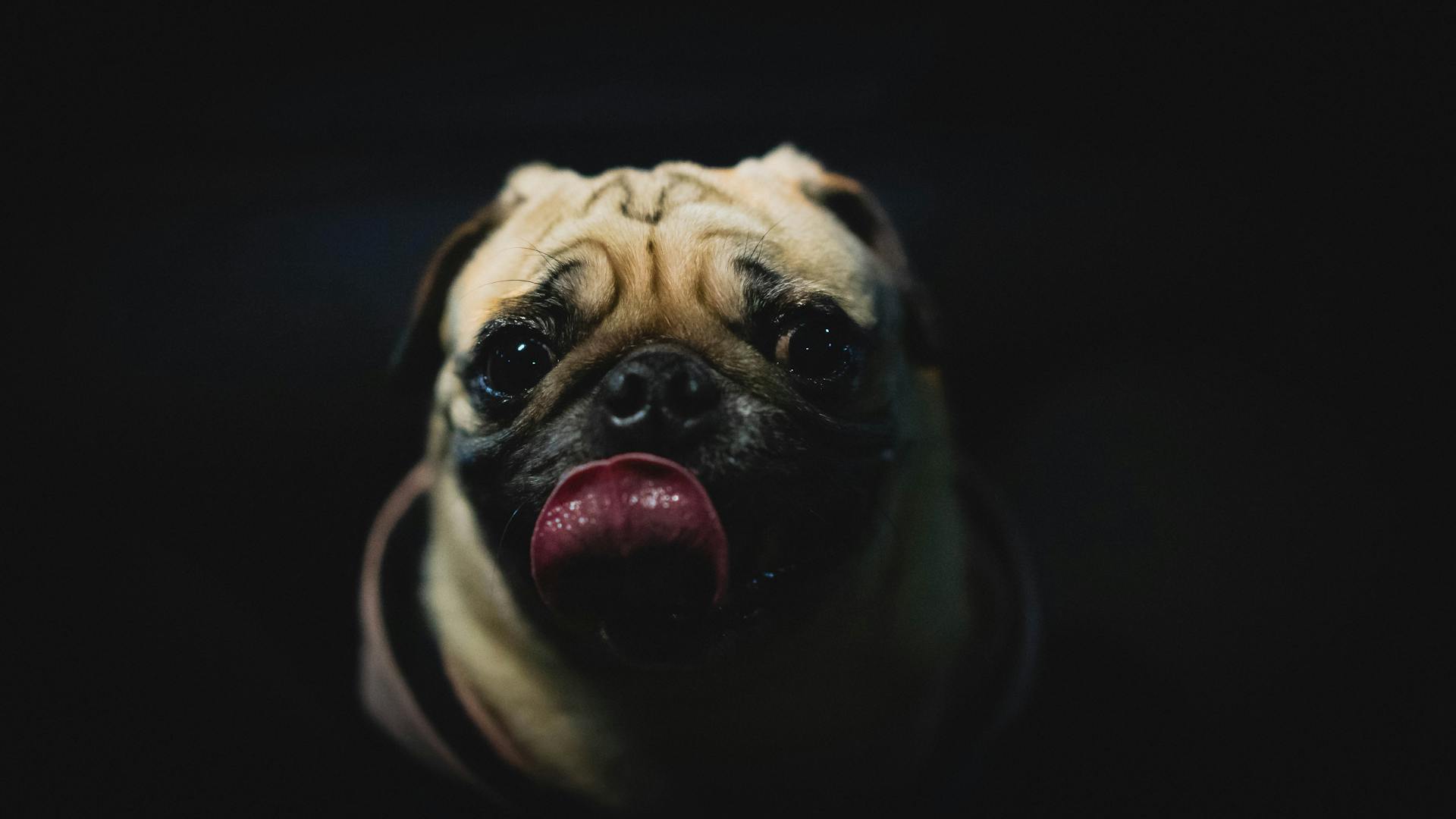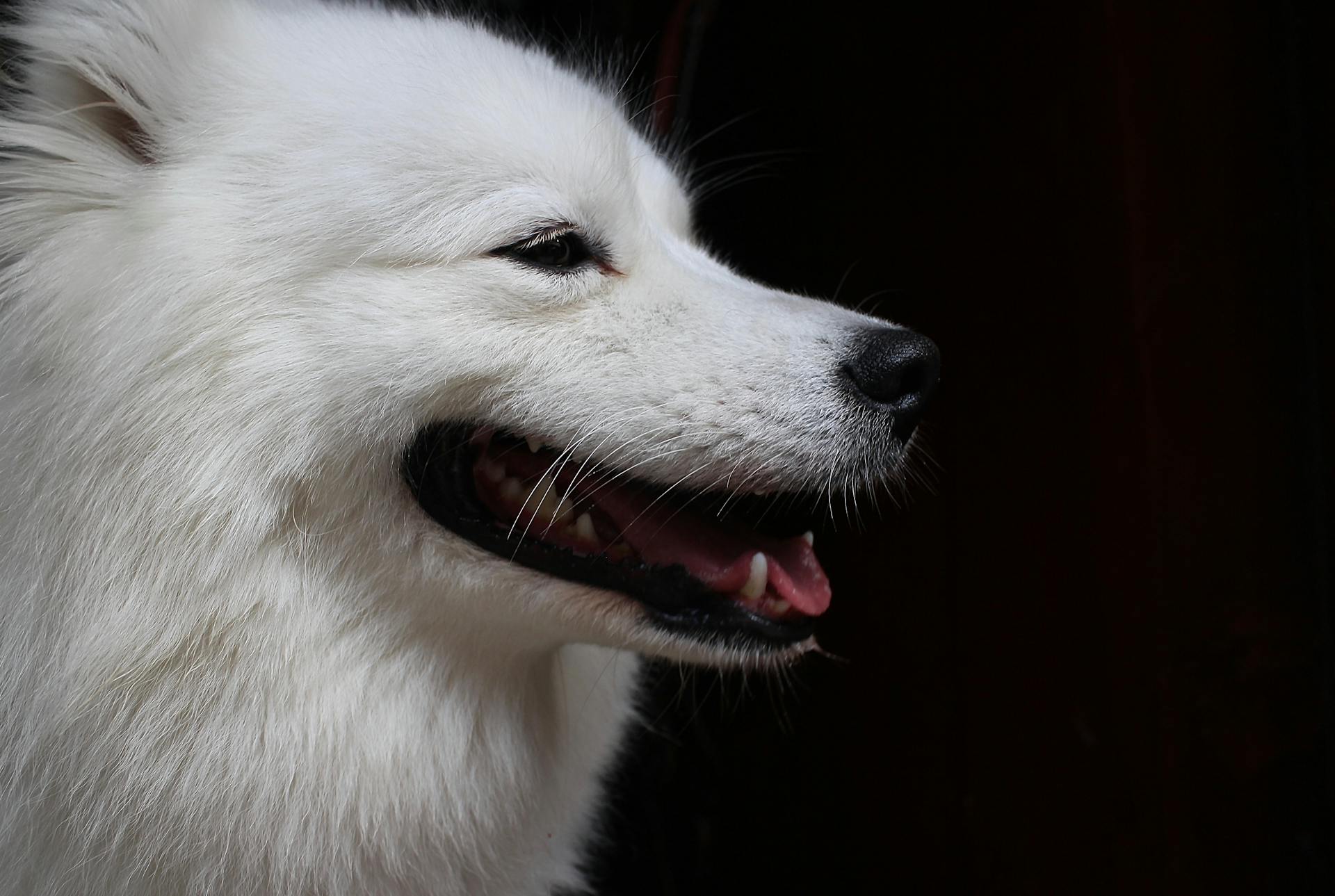
The Japanese Spitz is a small, fluffy dog breed that's perfect for city living. They weigh between 8-14 kg and stand about 20-25 cm tall.
Japanese Spitz dogs are known for their thick, white coats that require regular grooming to prevent matting. They have a wedge-shaped head, erect ears, and a curved tail.
Their friendly and outgoing personalities make them great family pets, but they can be wary of strangers at first. They are generally good with children if socialized properly.
Japanese Spitz dogs are relatively low-maintenance pets, requiring short daily walks and playtime.
Physical Characteristics
The Japanese Spitz is a stunning breed with a thick, snow white stand-off coat that's surprisingly easy to maintain. A brush once a week is usually enough, except for when they shed their coat twice a year, which requires daily brushing to remove the dead hair.
Their coat is made up of a long straight outer coat and a soft undercoat, which gives it a silky texture that repels mud and dirt. This means you can say goodbye to muddy paws and hello to a pristine white coat that's always looking its best.
Their head has a sharply pointed muzzle and triangular shaped ears that stand erect, giving them a noble and dignified appearance. Their tail is of medium length, with a rich fringe of long hair that's curled over their back, adding to their elegant and spirited look.
General Appearance
The Japanese Spitz has a unique and striking appearance that's hard to ignore. Its snow-white coat is one of its most distinctive features, standing off the body and requiring regular grooming to maintain its pristine condition.
The ideal ratio of height at the shoulders to length of body is 10:11, giving the breed a balanced and harmonious appearance. This ratio is crucial in determining the overall quality of the dog's physique.
The Japanese Spitz has a pointed muzzle, triangular-shaped ears, and a bushy tail curled over its back, which adds to its elegant and spirited appearance. Its prick ears are a defining characteristic of the breed.
Here are the average measurements for Japanese Spitz dogs and bitches:
The Japanese Spitz's tail is set high and carried curled over the middle of the back, adding to its dignified and elegant appearance. A moderately long tail is preferred, with a serious fault being a tail not carried on the back.
Related reading: Straight Backed German Shepherds
Eyes
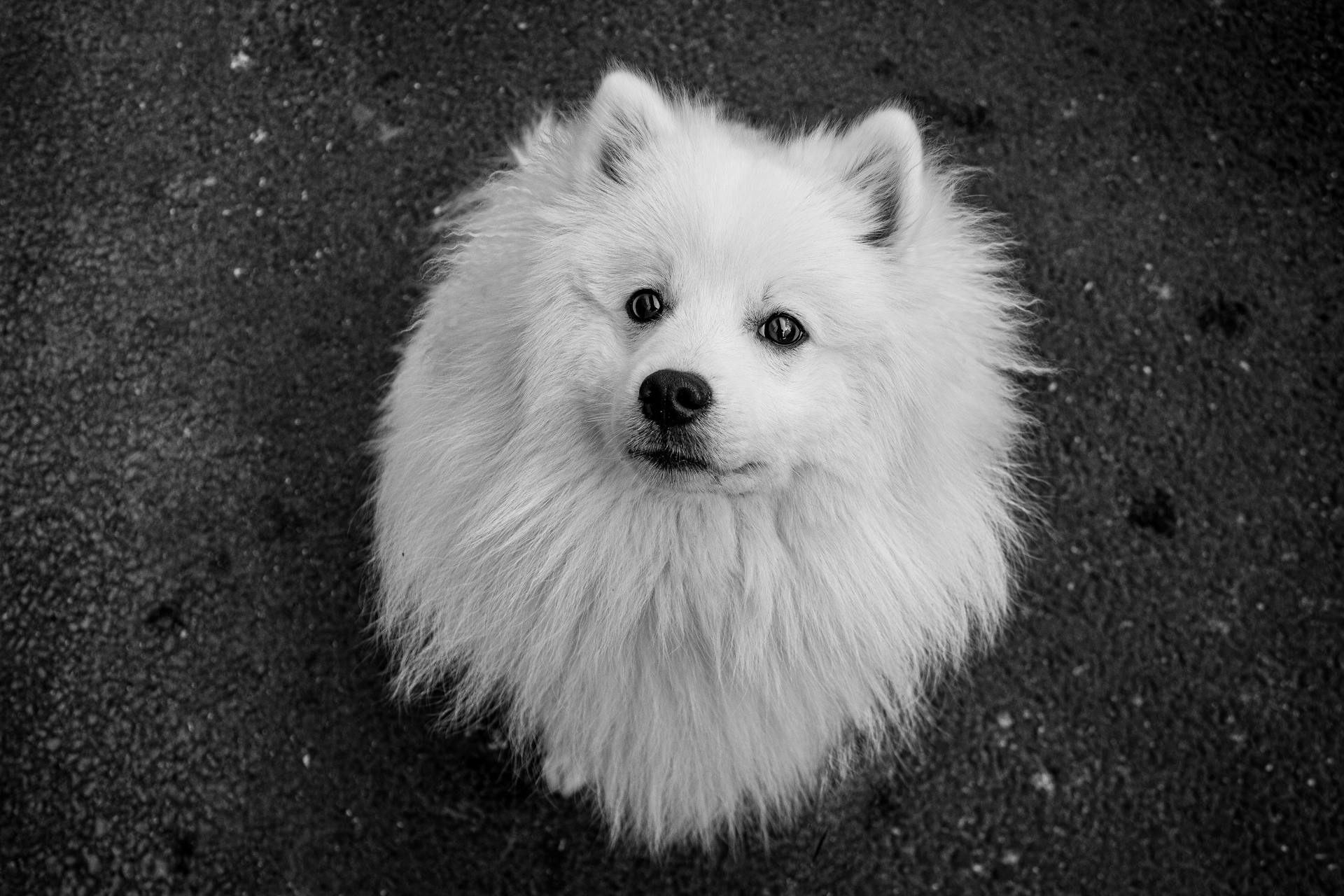
The eyes are a distinctive feature of this species, and they're quite noticeable. They're moderately large, and almond to oval in shape.
Their placement on the face is slightly off-center, which gives them an interesting appearance. The eyes are set slightly obliquely.
Dark eye rims frame the eyes, adding to their striking appearance.
Gait
When it comes to a dog's gait, you want it to be smooth and energetic.
A light and nimble gait is a great sign of a healthy and active dog.
The head carriage of a dog in motion should be high and proud, giving it a regal appearance.
Breed Characteristics
The Japanese Spitz is a wonderful breed, known for their gentle temperament and ease of training. They're perfect for families with kids, as they're generally very affectionate and loving.
They're also surprisingly intelligent, with a high trainability level, making them a joy to work with. With regular exercise, they're happy to adapt to smaller living spaces, such as apartments.
Here are some key characteristics of the Japanese Spitz breed:
Overall, the Japanese Spitz is a loyal and loving companion that's sure to bring joy to any family.
Origin of the
The Japanese Spitz was originally created from at least two varieties of dogs: the American Eskimo and a white Russian Spitz (Laika) imported to Japan via Manchuria.
The breed's origins are shrouded in mystery, and various theories have been put forward about its creation.
The direct utilization of the German Spitz to develop the original Japanese Spitz is still under debate, even if it is likely.
The Japanese Spitz has some remarkable similarities with the Samoyed, but it's unlikely that the Samoyed is a direct descendant of the breed.
After the Second World War, the Japanese Spitz suffered from uncontrolled cross-breeding with other similar dogs, including the German Spitz, American Eskimo, and Samoyed.
Fortunately, the efforts of breed fanciers managed to save the Japanese Spitz from significant debasement in time.
Characteristics
The Japanese Spitz is a breed that's perfect for families, especially those with kids. They have a gentle temperament and are easy to train, making them a wonderful companion.
One of the most notable characteristics of the Japanese Spitz is their high intelligence. They are considered one of the smartest breeds out there, which makes them a joy to train and interact with.
Their affection level is also extremely high, which means they love to be around people and receive attention. They thrive on human companionship and make great lap dogs.
Here are some key characteristics of the Japanese Spitz:
They are also known for their bold and lively nature, which makes them great watch dogs. However, they can be wary of strangers at first, so it's essential to introduce them to new people gently.
Overall, the Japanese Spitz is a wonderful breed that's perfect for families who want a loyal and loving companion.
Three Little-Known Facts
Did you know that some breeds are naturally better suited to apartment living? The Basenji, for example, is a relatively quiet breed that doesn't bark much.
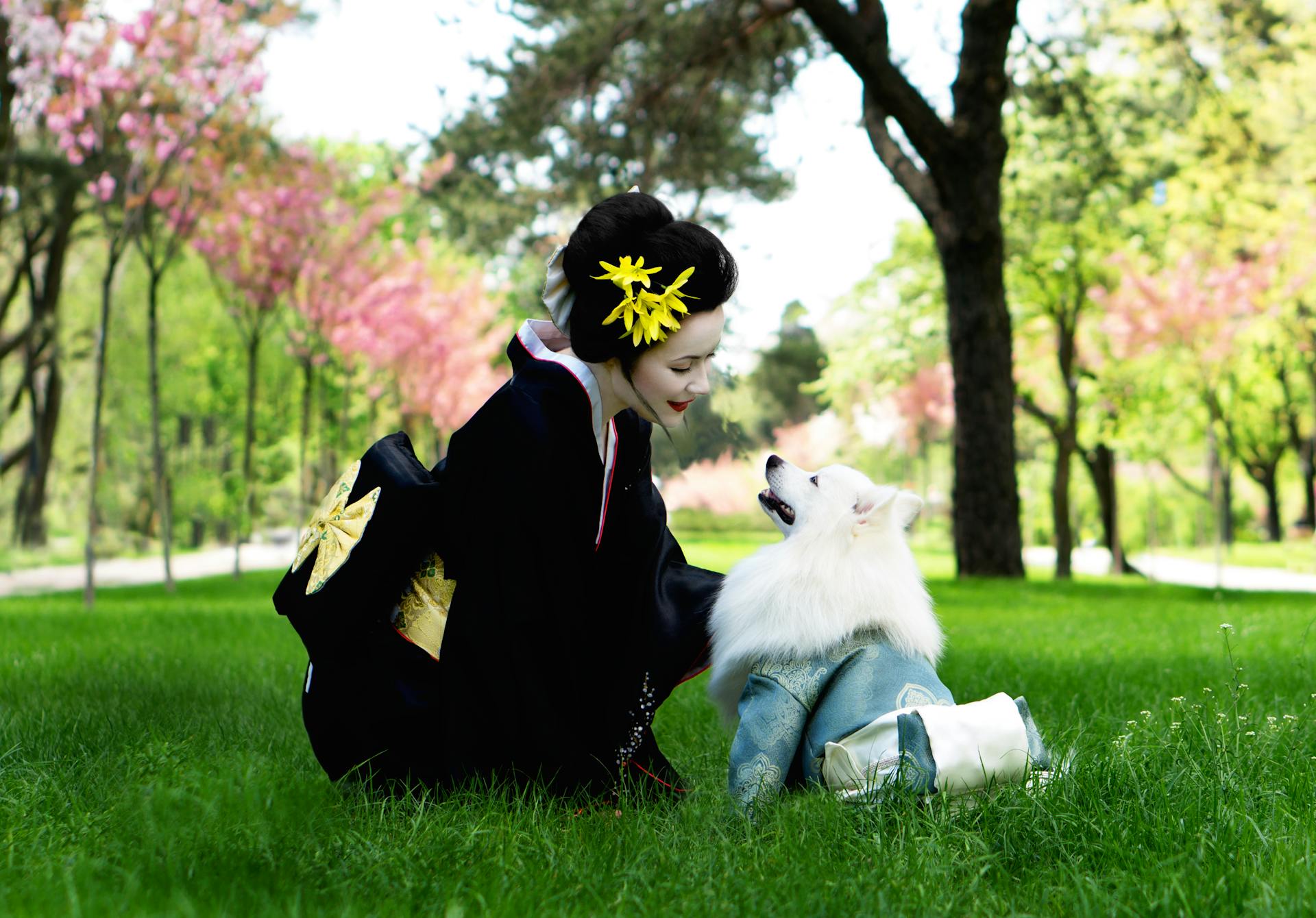
The Shiba Inu is known for its strong prey drive and high energy levels, making it a poor fit for homes with small pets.
Many breeds require regular grooming to prevent matting and tangling of their fur, such as the Afghan Hound, which needs to be brushed several times a week.
Care and Maintenance
The Japanese Spitz's coat is surprisingly easy to care for, requiring no trimming and only occasional baths, as the hair naturally repels dirt.
You can expect to bathe your Japanese Spitz about once a month, unless they get dirty or smelly, in which case you can bathe them more frequently.
They shed their coat twice a year, but this usually only lasts a week, and the dead hair can be easily brushed out.
To keep their coat looking its best, brush them daily, especially during shedding season, and use a pin brush to get into the undercoat and a slicker brush for the top portion of the coat.
You'll also need to brush behind their ears and under their tail, as these areas are prone to matting.
Don't over-bathe your Japanese Spitz, as this can strip their coat of its natural oils and lead to skin irritation.
Keep an eye on their ears and clean the outside with a wet cotton ball whenever it seems dirty, but avoid shoving anything into their ear canal.
Trim their nails regularly to prevent discomfort and the risk of infection.
Care
The Japanese Spitz is a low-maintenance breed when it comes to grooming, as their coat is surprisingly easy to care for and only requires occasional baths.
Their thick, fluffy coat naturally repels dirt, and they tend to look and feel clean with only occasional baths.
You can bathe them about once a month, or whenever they seem dirty or smelly, as over-bathing can strip the coat of its natural oils and lead to skin irritation.
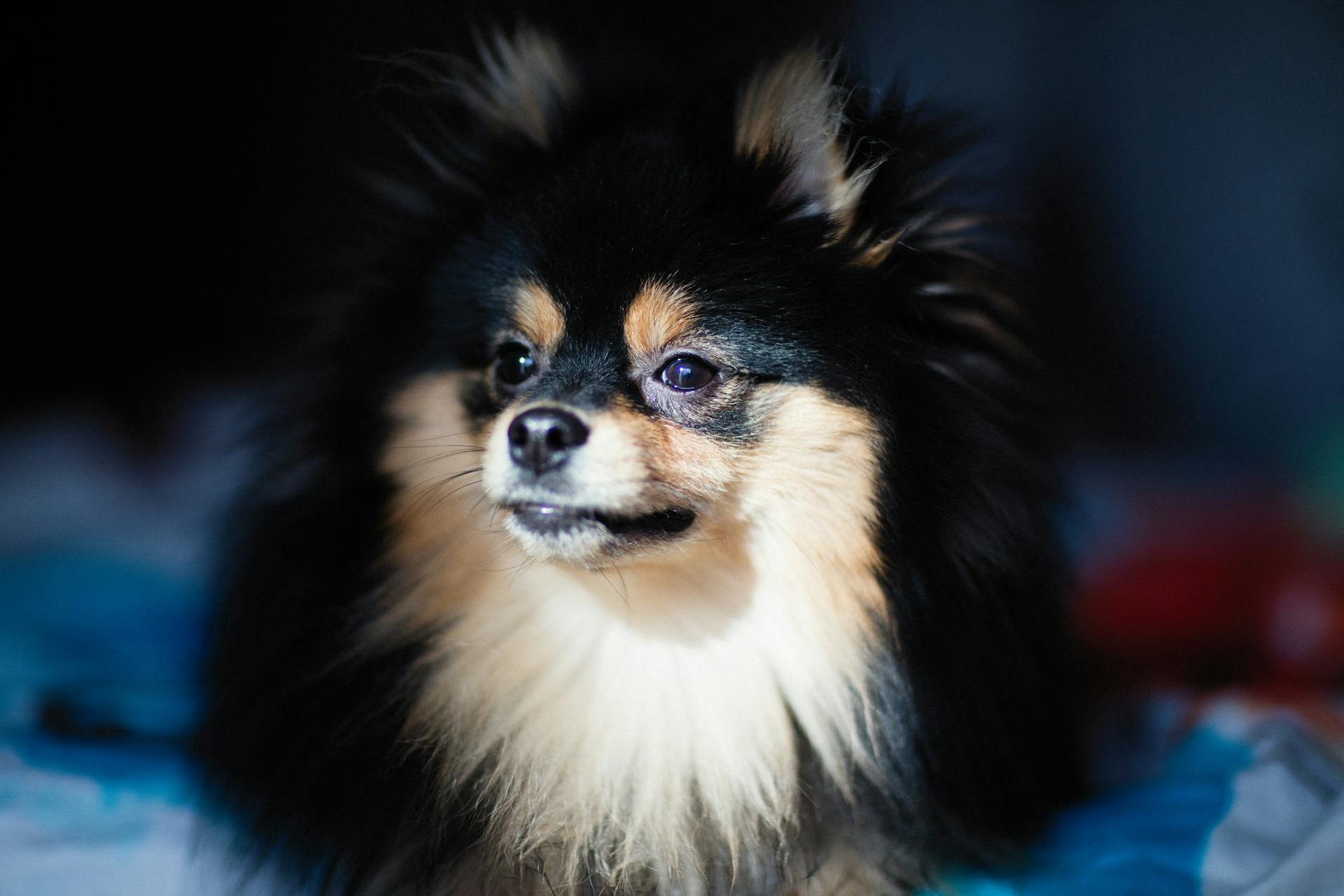
They shed their coat twice a year, but this usually only lasts one week, and the dead hair is easily brushed out.
In between shedding times, you'll need to brush them daily to help remove the dead hair, or take them to a professional groomer twice a year to remove the dead hair for you.
Their nails need to be trimmed regularly, as long nails are uncomfortable and can lead to painful and potentially infected splits.
You should start brushing your Japanese Spitz at a relatively young age to help them get used to regular brushing, making it much easier later on.
They don't need lots of exercise, but they are an active breed and enjoy being taken for a walk, and they can be mischievous if they're bored.
They thrive on human companionship, but are happy to be the only dog in the backyard, and they love living both indoors and outdoors with you.
Exercise
Japanese Spitz dogs are energetic, but they don't need huge amounts of exercise. A daily walk and some play sessions in the backyard will keep them happy.
Their small size makes them very portable, and they love to accompany their people on excursions outside the house. If you live in an apartment, it's essential to get your Japanese Spitz out of the house for walks and exploration.
Two brisk, 30-minute walks are enough to keep your Japanese Spitz happy and fit. You should stay moving during these walks, but also allow time for sniffing and exploring to prevent boredom.
Puppies require less exercise than adults, so be cautious not to overexercise them. Their bones and joints are still developing, and too much exercise may lead to health issues later on.
Recommended read: House Training Boston Terrier
Health and Nutrition
Feed your Japanese Spitz a high-quality dog food, and be sure to portion out meals with a measuring cup or scale to avoid overfeeding.
Japanese Spitz dogs don't have any special dietary needs, but they do require a quality puppy food when growing, as growing puppies need different nutrition than adults. Be sure to switch them to an adult food once they're done growing.
Overfeeding can lead to obesity, so carefully measure out your dog's food always. Follow the feeding directions on the food packaging, but feel free to adjust this according to your dog's needs. If your dog is gaining weight on the suggested feeding amount, you may need to decrease it.
Puppies need to be fed around 3 to 4 times a day, and more is typically better as it helps their blood sugar remain stable. As they grow, you can adjust them to two meals a day as adults.
Explore further: Shiba Inu Exercise Needs
Health and Conditions
The Japanese Spitz is generally a healthy breed with a long lifespan, but like all breeds, they can be prone to some health issues. Reputable breeders will often have their adult Japanese Spitz evaluated for luxating patellas to avoid passing on this issue.
Patellar luxation is a condition where the kneecap dislocates, and it can range from very mild to severe. In serious cases, it can cause lameness. Weight management and physical therapy can help control this condition, but surgery may be required in some instances.
Eye problems are another potential issue for Japanese Spitz dogs. Cataracts, glaucoma, and dry eye are all possible problems, and these conditions are treatable by a vet if caught early.
Dental problems are common in dogs, and Japanese Spitz are no exception. Around 80% of all adult dogs have gum disease, which can lead to more serious conditions if not prevented.
Tracheal collapse is a common issue for smaller dogs, and Japanese Spitz are no exception. It's usually not a complete collapse, but it can still cause problems and may require a trip to the vet.
Here are some potential health issues to be aware of:
- Allergies
- Tracheal collapse
- Dental issues
Patellar luxation is another potential issue, which can be caused by a dislocation of the kneecap.
Diet and Nutrition
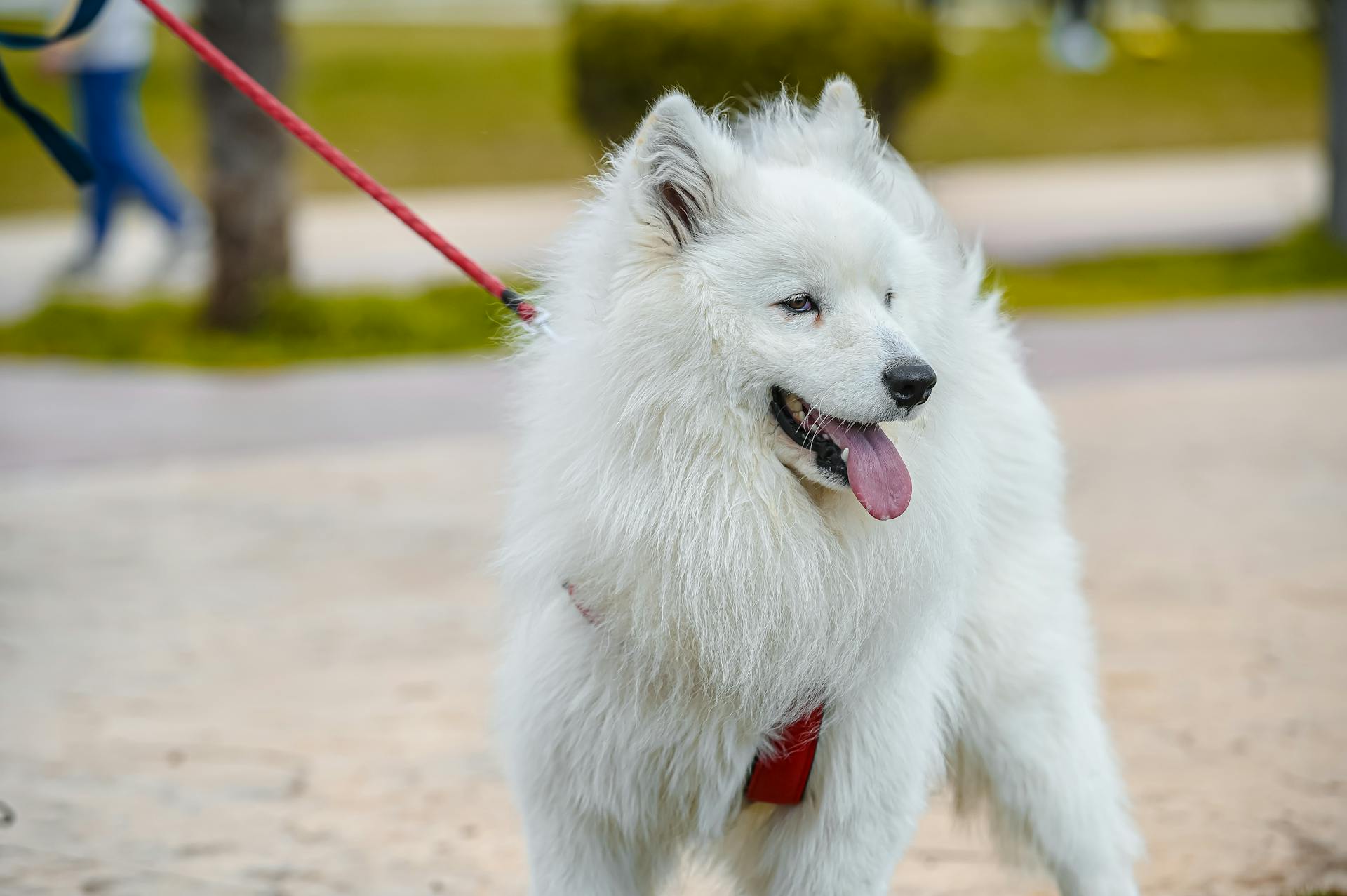
Feed your Japanese Spitz a high-quality dog food, and be sure to portion out meals with a measuring cup or scale to avoid overfeeding.
Free feeding can lead to weight gain, which can exacerbate joint issues and lead to other health problems like diabetes.
Japanese Spitz dogs don't have any special dietary needs, but they do well on any quality dog food designed for smaller dogs.
Smaller Japanese Spitz dogs may have trouble eating normally-sized kibble, so observe how your dog eats and make your own judgment on the size of food they need.
Growing puppies require different nutrition than adults, so be sure to feed a quality puppy food until your puppy is done growing.
Overfeeding can lead to obesity, so carefully measure out your dog's food always and follow the feeding directions on the food packaging.
If your dog is gaining weight on the suggested feeding amount, you may need to decrease it.
If this caught your attention, see: When Do Maltese Dogs Stop Growing
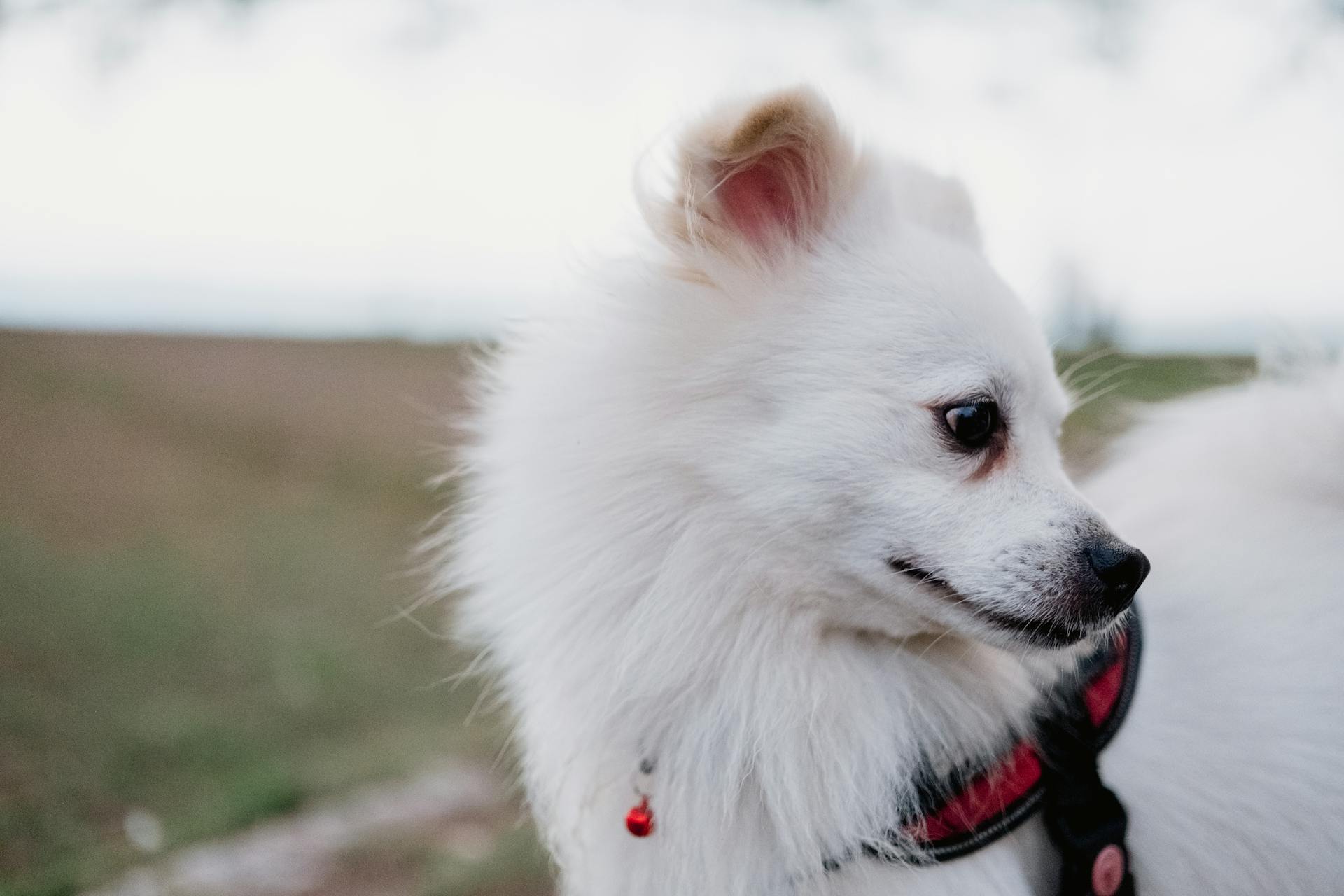
Puppies need to be fed around 3 to 4 times a day, and more is typically better to help their blood sugar remain stable.
As your Spitz grows into adulthood, you can adjust their diet to two meals a day, but keep an eye on their body condition and adjust their diet as necessary.
If your Spitz is particularly active, they may need more food or a formula specifically for active dogs, so be sure to speak with your vet for advice.
Check this out: When Is National Boston Terrier Day
Frequently Asked Questions
What are the downsides of Japanese Spitz?
Japanese Spitz can be high maintenance due to their high energy levels and strong curiosity, requiring regular exercise and potentially more effort to train. They may also be prone to escaping if left unattended in an unsecured garden.
How expensive is a Japanese Spitz?
The cost of a Japanese Spitz can range from $2500 to $4500, depending on its lineage and breeder reputation. Adoption or mixed-breed options may be more affordable.
Do Japanese Spitz bark a lot?
Japanese Spitz are generally calm dogs that bark infrequently, but may let out loud barks when encountering strangers. Proper socialization at a young age can help minimize this behavior.
Featured Images: pexels.com
